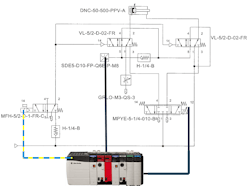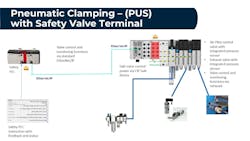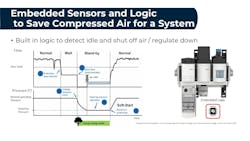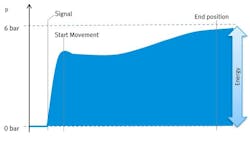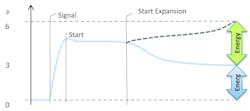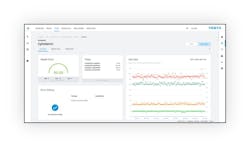How digitalization improves pneumatics safety, sustainability and uptime
Leveraging digital technologies, such as Ethernet, Internet of Things (IoT) and edge computing, can improve the safety, sustainability and uptime of pneumatic systems. Digital technology will also enhance the business metrics of pneumatics by lowering the number of components and enabling solutions that are easier and faster to design, assemble, bring to market, operate and troubleshoot.
What is digitalization?
ARC Advisory Group defines digitalization as Internet-enabled business improvement strategies. Digital enablers for pneumatic systems include programmable logic controllers (PLCs), embedded microcontrollers, sensors and edge controllers all linked via Ethernet. The pneumatic system depicted in Figure 1 shows the key elements of a digitalized pneumatic system.
The digitally communicated data from IO-Link enabled pressure, flow and temperature sensors opens a window into the operational health of the system.
Devices with embedded logic, such as an air preparation energy savings unit and intelligent valve manifold, monitor and control compressed air consumption with the goal of lowering energy usage.
Ethernet communication provides the bandwidth to run multiple message types over the same network. This includes safety devices, with the required built-in redundancy for processors and I/O channels.
An industrial PC, “edge controller,” co-exists on the same network. The edge controller merges data and provides information on premises and to the cloud.
Digitalization improves business and operational performance when developing safety circuits, lowering compressed air energy consumption and moving from preventive maintenance to predictive analytics.
Digitalized safety circuits
Some of the functions that safe circuits in pneumatics can be used for are to prevent unexpected startup (PUS), rapidly exhaust air to remove the potential of cylinder activation and provide for safe reversing of actuators.
For example, consider a safety circuit that reduces the risk of serious injury and is rated at level PLd Cat. 3 (Figure 2). The most effective way to achieve a PLd Cat. 3 safe circuit in pneumatics is with a dual-channel system where a safety PLC provides the necessary redundancy by offering two channels for control and monitoring. In addition to the PLC, this safety circuit includes:
- two solenoid valves
- two air pilot valves
- two check valves
- flow control
- pressure sensor.
Installing safe circuits can be time-consuming due to the number of components, as well as difficult to troubleshoot. Digitalization can simplify this classic safety circuit by integrating safety into a valve manifold, as shown in Figure 3. This solution for PUS has no need to exhaust compressed air out of the system. By avoiding exhaust, the PUS strategy saves energy, and the machine does not need to recharge, which saves time.
To summarize the benefits of digitalization on functional safety for pneumatics are:
- less time to implement and troubleshoot
- less time to scale up with software and network
- if PUS is optimum for the application, the system will save compressed air and eliminate recharge time
- integrated safety solution eliminates generic pulse test effect on coils and increases coil life expectancy
- IoT benefits such as counting faults, triggers and cycles accrue
- inherent condition monitoring improves maintenance.
Digitalization for sustainability
The digitalization of pneumatic systems lowers compressed air and energy usage and contributes savings that help meet carbon emission reduction goals. In a digitalized system, functionally integrated flow and pressure sensors, along with embedded logic in an air preparation unit, monitor compressed air consumed by a machine. When production stops temporarily, the air preparation unit blocks air flow, putting the system on standby mode. When production starts, the block is removed for full air flow. When the machine is shut down, there will typically be some leakage. The air preparation system detects leakage and reduces pressure to standby, which lowers air loss. The system provides a soft start from standby mode when production resumes (Figure 4).
In classic pneumatic cylinder actuation, supply pressure equals cylinder pressure. The blue area in Figure 5 represents the total compressed air during a stroke.
Digitalization can save a small amount of energy per stroke per cylinder by reducing pressure to a minimum once inertia has been overcome and the piston is moving. These small savings grow over many cycles.
The area indicated by the green arrow of Figure 6 shows the savings in compressed air by minimizing pressure after the piston starts. Minimum pressure in the chamber also reduces exhaust time and improves cylinder dynamics and energy efficiency.
To achieve this cylinder level eco-strategy, machine builders set up a function block in the PLC to control pressure. The builder assigns a variable for sensors, coils, timing and limit values. An algorithm in the function block determines the shutoff time for best movement. I/O data is transferred via the Ethernet network.
Get your subscription to Control Design’s daily newsletter.
In summary, functional integration within an air preparation unit can save energy over the entire machine while an eco-strategy can reduce energy per cylinder.
Digitalization for predictive analytics
Predictive analytics, the capability of identifying pending component or system failure well before that failure occurs, lowers the risk of unplanned shutdown and improves maintenance department resource allocation. Predictive analytics also have a quality component. By maintaining performance within the optimum range, manufacturers can be assured products are within specification.
To achieve predictive analytics, there must be seamless integration of data and analysis over an Ethernet network. Figure 7 shows an edge controller initiating commands—black arrows—to read data from devices, based on specific data models for each device. The edge controller can, in this example, periodically retrieve specific information from the air preparation system and smart valve manifold to ascertain energy saving.
This information can include:
- asset info (serial number, part number, IP address)
- process info (pressure, flow, consumption)
- diagnostic: (errors, cycle counts, operating hours).
This information gathered and resident on the edge controller can be contextualized with data from other devices with a visual programming tool, such as Node-RED. The contextualized data provides the basis for a health score or any key performance indicator.
MQTT software publishes data to an intermediate broker where information can be distributed. The outcome is a visual representation of the health of the system.
Data from PLCs and valve manifolds can also be used to focus on the health of individual cylinders. The data sets include information from the coil and from switch signals.
A machine-learning algorithm running on the edge controller learns proper conditions from an optimized system. Once the training is complete, continuous monitoring can evaluate whether the behavior is straying from the model. A worsening score is a prediction of failure, and the individual cylinder can be scheduled for maintenance before an unplanned shutdown occurs. This information can be monitored from the cloud or on premises. Figure 8 shows a dashboard for a cylinder that has no risk of failure, as it operates at 99.89 health based on real-time data.
Digitalization enables improvement in the machine builder’s business by simplifying design and implementation and lowering the number of components, all of which help bring machines to market more quickly. The end user will find higher quality output and reduced risk of unplanned shutdown. The tools and knowledge to make these improvements through digitalization are available.
About the Author
Frank Latino
Festo
Frank Latino is global product manager, electric automation, at Festo, where he's been for 30 years. His expertise is in network technologies and control systems for industrial automation. Contact him at [email protected].


